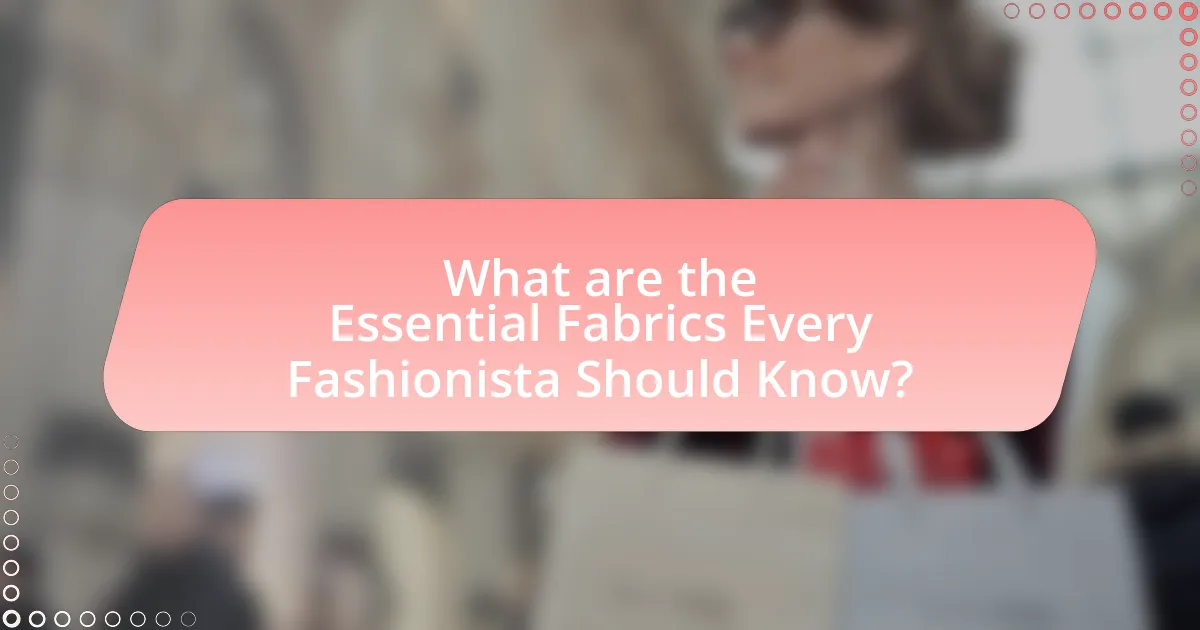The article focuses on essential fabrics that every fashionista should be familiar with, including cotton, silk, wool, linen, and polyester. It emphasizes the importance of understanding these fabrics in relation to garment quality, durability, and design choices. Key characteristics of natural and synthetic fabrics are discussed, highlighting their unique properties and how they influence fashion decisions. Additionally, the article covers fabric care, the significance of fabric weight and texture, and the latest trends in fabric technology, particularly in sustainability and performance. This comprehensive overview serves as a guide for fashion enthusiasts to make informed choices in their fabric selections.

What are the Essential Fabrics Every Fashionista Should Know?
The essential fabrics every fashionista should know include cotton, silk, wool, linen, and polyester. Cotton is widely appreciated for its breathability and versatility, making it suitable for various clothing types. Silk is valued for its luxurious feel and natural sheen, often used in high-end garments. Wool is recognized for its warmth and durability, ideal for colder climates and tailored pieces. Linen is favored for its lightweight and breathable qualities, perfect for summer wear. Polyester is a synthetic fabric known for its durability and wrinkle resistance, commonly blended with other materials to enhance performance. Each of these fabrics plays a significant role in fashion, offering unique properties that cater to different styles and occasions.
Why is understanding fabrics important for fashionistas?
Understanding fabrics is crucial for fashionistas because it directly influences design choices, garment quality, and overall style. Knowledge of different fabrics enables fashionistas to select materials that enhance the aesthetic and functional aspects of their creations. For instance, natural fibers like cotton and silk offer breathability and comfort, while synthetic fabrics like polyester provide durability and ease of care. This understanding allows fashionistas to make informed decisions that align with current trends and consumer preferences, ultimately impacting the success of their fashion endeavors.
How do different fabrics influence fashion choices?
Different fabrics significantly influence fashion choices by affecting the garment’s appearance, comfort, and functionality. For instance, natural fabrics like cotton and linen are often chosen for their breathability and comfort in warm weather, while synthetic fabrics like polyester and nylon are favored for their durability and moisture-wicking properties. Additionally, the texture and drape of fabrics can alter the silhouette of a garment, impacting style decisions; for example, silk provides a luxurious sheen and flow, making it popular for evening wear. Studies indicate that fabric choice can also affect consumer perception and emotional response, with certain materials evoking feelings of luxury or casualness, thereby guiding fashion preferences and purchasing behavior.
What role do fabrics play in garment quality and durability?
Fabrics significantly influence garment quality and durability by determining the overall performance, feel, and lifespan of clothing. High-quality fabrics, such as cotton, wool, and silk, offer better breathability, moisture-wicking properties, and resistance to wear and tear compared to lower-quality alternatives like polyester or rayon. For instance, cotton is known for its softness and durability, making it a preferred choice for everyday wear, while wool provides excellent insulation and resilience, enhancing the longevity of garments. Studies have shown that garments made from high-quality fabrics can withstand more washes and maintain their shape and color longer, thereby contributing to overall durability.
What are the most common types of fabrics in fashion?
The most common types of fabrics in fashion include cotton, polyester, silk, wool, and linen. Cotton is widely used due to its breathability and comfort, making it ideal for casual wear and everyday clothing. Polyester is favored for its durability and wrinkle resistance, often found in activewear and formal attire. Silk is known for its luxurious feel and sheen, commonly used in high-end garments and evening wear. Wool provides warmth and insulation, making it a popular choice for winter clothing. Linen is appreciated for its lightweight and breathable qualities, especially in summer apparel. These fabrics are foundational in the fashion industry, each serving specific purposes and preferences among consumers.
What are natural fabrics and why are they favored?
Natural fabrics are textiles made from fibers derived from plants, animals, or minerals, such as cotton, linen, wool, and silk. They are favored for their breathability, comfort, and biodegradability, making them more environmentally friendly compared to synthetic fabrics. Additionally, natural fabrics often possess unique qualities, such as moisture-wicking properties in wool and the softness of cotton, which enhance their appeal in fashion. The preference for these materials is supported by consumer trends that increasingly prioritize sustainability and ethical sourcing in the fashion industry.
What are synthetic fabrics and what advantages do they offer?
Synthetic fabrics are man-made textiles created from chemical processes, primarily derived from petroleum products. These fabrics, such as polyester, nylon, and acrylic, offer several advantages including durability, resistance to wrinkles and shrinking, and ease of care. For instance, polyester is known for its strength and quick-drying properties, making it ideal for activewear. Additionally, synthetic fabrics often have moisture-wicking capabilities, which enhance comfort during physical activities. Their ability to retain color and resist fading also contributes to their popularity in fashion, as they maintain a fresh appearance over time.
How do fabric properties affect fashion design?
Fabric properties significantly influence fashion design by determining the garment’s drape, texture, durability, and overall aesthetic. For instance, fabrics like silk offer a luxurious feel and elegant drape, making them ideal for evening wear, while cotton provides breathability and comfort, suitable for casual attire. Additionally, the stretchability of fabrics such as spandex allows for fitted designs that enhance body shape, which is crucial in activewear. The weight of the fabric also affects the silhouette; heavier fabrics create structured looks, while lighter materials contribute to flowy designs. These properties guide designers in selecting appropriate materials that align with their creative vision and the intended functionality of the clothing.
What is the significance of fabric weight in clothing design?
Fabric weight is significant in clothing design as it directly influences the garment’s drape, durability, and suitability for specific seasons. Heavier fabrics, such as denim or wool, provide structure and warmth, making them ideal for colder weather, while lighter fabrics like cotton or chiffon offer breathability and flow, suitable for warmer climates. The choice of fabric weight affects not only the aesthetic appeal but also the functionality of the clothing, as different weights can enhance or hinder movement and comfort. For instance, a study published in the Journal of Fashion Technology & Textile Engineering highlights that fabric weight impacts consumer preferences, with heavier fabrics often associated with quality and longevity.
How does fabric texture impact the overall look of an outfit?
Fabric texture significantly influences the overall look of an outfit by affecting its visual appeal and tactile experience. Different textures, such as smooth silk, coarse wool, or soft cotton, create distinct styles and moods; for instance, silk conveys elegance, while denim suggests casualness. The interplay of textures can also enhance depth and interest in an outfit, as layering various fabrics can create a more dynamic appearance. Studies in fashion psychology indicate that texture can evoke emotional responses, impacting how an outfit is perceived by others. Therefore, the choice of fabric texture is crucial in defining the aesthetic and emotional impact of clothing.

What are the key characteristics of popular fashion fabrics?
Popular fashion fabrics exhibit key characteristics such as versatility, durability, comfort, and aesthetic appeal. Versatility allows fabrics like cotton and polyester to be used in various styles and garments, making them staples in fashion. Durability is evident in materials like denim and leather, which withstand wear and maintain their appearance over time. Comfort is a significant factor in fabrics such as modal and bamboo, which provide a soft feel against the skin. Aesthetic appeal is highlighted in luxurious fabrics like silk and chiffon, known for their elegant drape and visual allure. These characteristics contribute to the selection and popularity of fabrics in the fashion industry.
What makes cotton a staple in fashion?
Cotton is a staple in fashion due to its versatility, breathability, and comfort. This natural fiber can be easily woven into various fabrics, making it suitable for a wide range of clothing styles, from casual wear to formal attire. Additionally, cotton’s moisture-wicking properties allow it to absorb sweat, enhancing comfort in warm weather. According to the Cotton Incorporated Lifestyle Monitor, 85% of consumers prefer cotton for its softness and comfort, reinforcing its popularity in the fashion industry.
How does cotton’s breathability benefit wearers?
Cotton’s breathability benefits wearers by allowing air circulation, which helps regulate body temperature and moisture levels. This property keeps the skin cool and dry, reducing the likelihood of overheating and discomfort during warm weather. Studies have shown that cotton can absorb up to 27 times its weight in water, enhancing its ability to wick moisture away from the body, thus promoting comfort and preventing skin irritation.
What are the different types of cotton fabrics available?
The different types of cotton fabrics available include percale, sateen, denim, muslin, and canvas. Percale is a tightly woven fabric known for its crisp feel and durability, often used in bed linens. Sateen has a smooth, lustrous finish due to its satin weave, making it popular for upscale bedding and clothing. Denim, a sturdy cotton twill fabric, is primarily used for jeans and casual wear. Muslin is a lightweight, plain weave fabric often used for making patterns and garments. Canvas is a heavy-duty fabric used for bags, tents, and upholstery due to its strength and durability. Each type serves distinct purposes in fashion and home textiles, showcasing the versatility of cotton.
Why is silk considered a luxury fabric?
Silk is considered a luxury fabric due to its unique properties, including its softness, sheen, and lightweight nature. The production of silk is labor-intensive, requiring the cultivation of silkworms and careful harvesting of silk fibers, which contributes to its high cost. Additionally, silk has a natural ability to regulate temperature and wick moisture, making it comfortable to wear in various climates. Historically, silk has been associated with wealth and status, as it was once a rare commodity traded along the Silk Road, further solidifying its reputation as a luxury material.
What are the unique properties of silk that enhance its appeal?
Silk possesses unique properties such as natural sheen, softness, and breathability that enhance its appeal. The natural sheen of silk results from its triangular prism-like structure, which reflects light beautifully, giving it a luxurious appearance. Its softness is attributed to the smooth fibers, making it comfortable against the skin. Additionally, silk is highly breathable due to its protein structure, allowing moisture to evaporate and regulating body temperature, which is particularly beneficial in varying climates. These properties contribute to silk’s reputation as a premium fabric in fashion, often associated with elegance and sophistication.
How should silk garments be cared for to maintain quality?
Silk garments should be cared for by hand washing or dry cleaning to maintain their quality. Hand washing in cold water with a gentle detergent prevents damage, while dry cleaning is recommended for more delicate pieces. Additionally, silk should be air-dried away from direct sunlight to prevent fading and maintain its luster. Using a cool iron can help remove wrinkles, but it is essential to place a cloth between the iron and the silk to avoid scorching. These methods are supported by textile care guidelines, which emphasize the fragility of silk fibers and the importance of gentle handling to preserve their integrity.
What are the benefits of using wool in fashion?
Wool offers numerous benefits in fashion, including its natural insulation, moisture-wicking properties, and durability. The insulation provided by wool helps regulate body temperature, keeping wearers warm in cold conditions and cool in warmer climates. Additionally, wool can absorb moisture up to 30% of its weight without feeling wet, which enhances comfort and reduces odor. Its durability is evidenced by its ability to withstand wear and tear, making wool garments long-lasting. Studies show that wool fibers can bend up to 20,000 times without breaking, significantly outperforming many synthetic fibers in terms of longevity.
How does wool provide insulation and comfort?
Wool provides insulation and comfort primarily due to its unique fiber structure, which traps air and creates a thermal barrier. This structure allows wool to maintain body heat in cold conditions while also wicking moisture away from the skin, keeping the wearer dry and comfortable. Studies have shown that wool can absorb up to 30% of its weight in moisture without feeling wet, which enhances its comfort level. Additionally, the natural crimp in wool fibers contributes to their ability to insulate, as it increases the volume of air trapped within the fabric, further enhancing warmth.
What types of wool fabrics are commonly used in clothing?
Common types of wool fabrics used in clothing include Merino wool, cashmere, lambswool, and tweed. Merino wool is known for its softness and moisture-wicking properties, making it ideal for base layers and activewear. Cashmere, derived from cashmere goats, is prized for its luxurious feel and warmth, often used in high-end sweaters and scarves. Lambswool, from the first shearing of lambs, is soft and resilient, commonly found in sweaters and outerwear. Tweed, a traditional fabric, is characterized by its durability and texture, frequently used in jackets and coats. These wool fabrics are favored for their thermal insulation, breathability, and versatility in various clothing styles.

How can fashionistas choose the right fabric for their needs?
Fashionistas can choose the right fabric for their needs by considering the garment’s purpose, climate, and personal style. For instance, lightweight cotton is ideal for summer wear due to its breathability, while wool is suitable for winter garments because of its insulation properties. Additionally, understanding fabric characteristics, such as stretch in spandex blends for activewear or drape in silk for evening dresses, helps in making informed choices. Research indicates that fabric selection significantly impacts comfort and functionality, with studies showing that 70% of consumers prioritize fabric feel when purchasing clothing.
What factors should be considered when selecting fabric for a garment?
When selecting fabric for a garment, key factors include the fabric’s composition, weight, drape, durability, and care requirements. The composition affects the garment’s feel, breathability, and stretch; for example, cotton is breathable while polyester is durable. Weight influences how the fabric hangs and moves; lightweight fabrics are suitable for summer wear, while heavier fabrics are ideal for winter. Drape determines how the fabric falls on the body, impacting the overall silhouette of the garment. Durability is crucial for longevity, with some fabrics like denim being more resilient than others like silk. Lastly, care requirements dictate how easy it is to maintain the garment, with some fabrics requiring dry cleaning while others can be machine washed.
How do climate and seasonality influence fabric choice?
Climate and seasonality significantly influence fabric choice by dictating the suitability of materials for different weather conditions. For instance, lightweight fabrics like cotton and linen are preferred in hot climates and summer seasons due to their breathability and moisture-wicking properties, which help keep the body cool. Conversely, in colder climates and winter seasons, heavier fabrics such as wool and flannel are favored for their insulation and warmth retention capabilities. This selection process is supported by the fact that the global textile industry adapts to seasonal trends, with retailers often introducing collections that align with the climatic demands of specific regions, ensuring that consumers have access to appropriate fabrics year-round.
What is the importance of fabric drape in garment design?
Fabric drape is crucial in garment design as it directly influences the silhouette, fit, and overall aesthetic of a piece. The way a fabric falls and moves on the body affects how the garment is perceived, impacting both comfort and style. For instance, fabrics with a soft drape, like silk or jersey, create a fluid look that enhances movement, while stiffer fabrics, such as denim or canvas, provide structure and shape. This relationship between fabric drape and design is supported by studies indicating that drape affects visual perception and consumer preferences in fashion, highlighting its significance in creating appealing garments.
What are some tips for caring for different types of fabrics?
To care for different types of fabrics, it is essential to follow specific guidelines tailored to each material. For cotton, wash in cold water to prevent shrinkage and use a gentle detergent. For wool, hand wash or use a wool cycle on the machine with cold water to maintain its shape and softness. Silk requires dry cleaning or a delicate hand wash with mild soap to avoid damage. Polyester can be machine washed in warm water and tumble dried on low heat, as it is durable and resists wrinkles. Linen should be washed in cold water and air-dried to prevent creasing. These care tips are supported by fabric care labels, which provide specific instructions for maintaining the integrity and appearance of each fabric type.
How can proper care extend the life of fashion fabrics?
Proper care can significantly extend the life of fashion fabrics by preventing damage from wear, tear, and environmental factors. Regular washing according to fabric care labels, using appropriate detergents, and avoiding harsh chemicals help maintain the integrity of fibers. For instance, washing in cold water can prevent shrinkage and fading, while air drying reduces the risk of heat damage from dryers. Additionally, proper storage techniques, such as using breathable garment bags and avoiding overcrowding, can prevent creasing and fabric distortion. Studies indicate that fabrics maintained with proper care can last up to 50% longer than those subjected to neglect, highlighting the importance of these practices in preserving fashion items.
What are common mistakes to avoid when caring for fabrics?
Common mistakes to avoid when caring for fabrics include using incorrect washing temperatures, neglecting to read care labels, and using harsh detergents. Washing fabrics at inappropriate temperatures can lead to shrinkage or damage; for instance, washing wool in hot water can cause it to felt. Not reading care labels often results in using unsuitable cleaning methods, which can ruin the fabric’s texture or color. Additionally, harsh detergents can degrade fibers over time, leading to premature wear. Proper care ensures longevity and maintains the appearance of fabrics.
What are the latest trends in fabric technology for fashionistas?
The latest trends in fabric technology for fashionistas include the development of sustainable materials, smart textiles, and performance-enhancing fabrics. Sustainable materials, such as recycled polyester and organic cotton, are gaining popularity due to increasing consumer demand for eco-friendly fashion. Smart textiles, which integrate technology for functionalities like temperature regulation and moisture-wicking, are being embraced for their innovative applications in everyday wear. Performance-enhancing fabrics, such as those with anti-odor and stain-resistant properties, are also trending, catering to the active lifestyle of modern fashionistas. These advancements reflect a shift towards combining style with functionality and sustainability in the fashion industry.
How are sustainable fabrics changing the fashion industry?
Sustainable fabrics are transforming the fashion industry by reducing environmental impact and promoting ethical practices. These materials, such as organic cotton, Tencel, and recycled polyester, significantly lower water usage and carbon emissions compared to conventional fabrics. For instance, organic cotton uses 91% less water than traditional cotton farming, while Tencel is produced from sustainably sourced wood pulp, utilizing a closed-loop process that recycles water and solvents. This shift towards sustainable fabrics is not only appealing to environmentally conscious consumers but also encourages brands to adopt more responsible sourcing and production methods, thereby reshaping industry standards and consumer expectations.
What innovations in fabric technology should fashionistas be aware of?
Fashionistas should be aware of innovations such as moisture-wicking fabrics, sustainable textiles, and smart fabrics. Moisture-wicking fabrics, like those made from polyester blends, draw sweat away from the body, enhancing comfort during physical activities. Sustainable textiles, including organic cotton and recycled polyester, reduce environmental impact and promote eco-friendly fashion. Smart fabrics, embedded with technology, can monitor body temperature and heart rate, offering functionality alongside style. These advancements are reshaping the fashion industry by combining performance, sustainability, and technology, making them essential for modern fashionistas.


